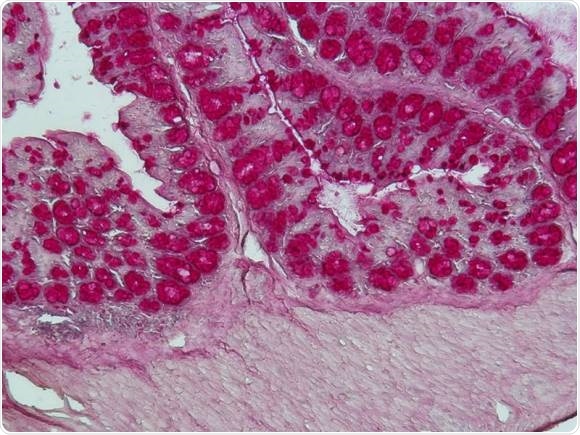Sep 13 2016
Countless microorganisms live in the intestinal tract. Researchers at the Technical University of Munich (TUM) have been able to demonstrate that intestinal bacteria also play a role in determining the strength of anaphylactic reactions to food allergens. The scientists presented their results at the annual convention of the European Society for Dermatological Research (ESDR), which is hosted by and at TUM this year.

The intestinal microbiota (shown here is a histological staining of a colon section) is significantly influencing the immune system of the host. (Picture: Caspar Ohnmacht / ZAUM)
The human microbiota - the entirety of bacteria which live e.g. on the skin or in the intestinal tract - has a complex influence on health. A team led by Prof. Tilo Biedermann, the director of the Clinic for Dermatology and Allergology at Rechts der Isar Hospital, examined the role microbiota plays in the digestive system in the case of food allergies.
The gut flora and the various elements of the immune system are closely interwoven and mutually influence each other. During its investigations, the team of researchers at TUM focused on a protein called NOD2. This receptor of the immune system is able to "recognize" intestinal bacteria - or more precisely, the main component of their cell wall - and initiate numerous complex processes. The scientists investigated the effects that occurred when this recognition receptor is absent.
A fundamentally changed immune reaction
Tilo Biedermann and his colleagues were able to demonstrate that when NOD2 was absent, the body's immune reaction changed fundamentally. Instead of cells such as regulatory T cells, which suppress an activation of the immune system, a greater number of what are called Th2 helper cells are formed.
These cells cause a larger number of the antibody immunoglobulin E (or IgE for short) to be produced. In persons suffering from food allergies, the IgE in the body has been "trained" for the corresponding allergens, and stimulates distinct cells to trigger an allergic reaction when it detects the allergen in the intestine, for example. The greater the amount of IgE, the stronger the allergic reaction.
Accordingly, the scientists observed particularly serious allergic reactions in mouse models when NOD2 was absent. The composition of the intestinal microbiota of these animals had also changed. Another aspect of the study demonstrates the true complexity of the interactions between microbiota and the immune system: When the composition of the intestinal bacteria was re-normalized, serious allergic reactions could be prevented even when NOD2 was absent.
Harmless bacteria as a new therapeutic approach
"This relationship between intestinal flora and the production of antibodies opens up new therapeutic approaches for patients whose microbiota is altered", said Tilo Biedermann. "For example, if it is possible to encourage harmless bacteria to colonize the intestines, this would also reduce the body's reaction to allergens."
So far, the findings have not yet been published. The scientists presented them on Thursday, September 8 at the main plenary session of the 46th annual convention of the European Society for Dermatological Research (ESDR). 1200 researchers travelled to Munich to attend the annual convention. This year's host and organizer is TUM. The topic "Microbiomes and Allergies" is one of the focal points of the convention. Prior to that, on Wednesday, September 7, Dr. Thomas Volz, a dermatologist at TUM, will be heading a symposium on skin bacteria titled "You'll never walk alone".